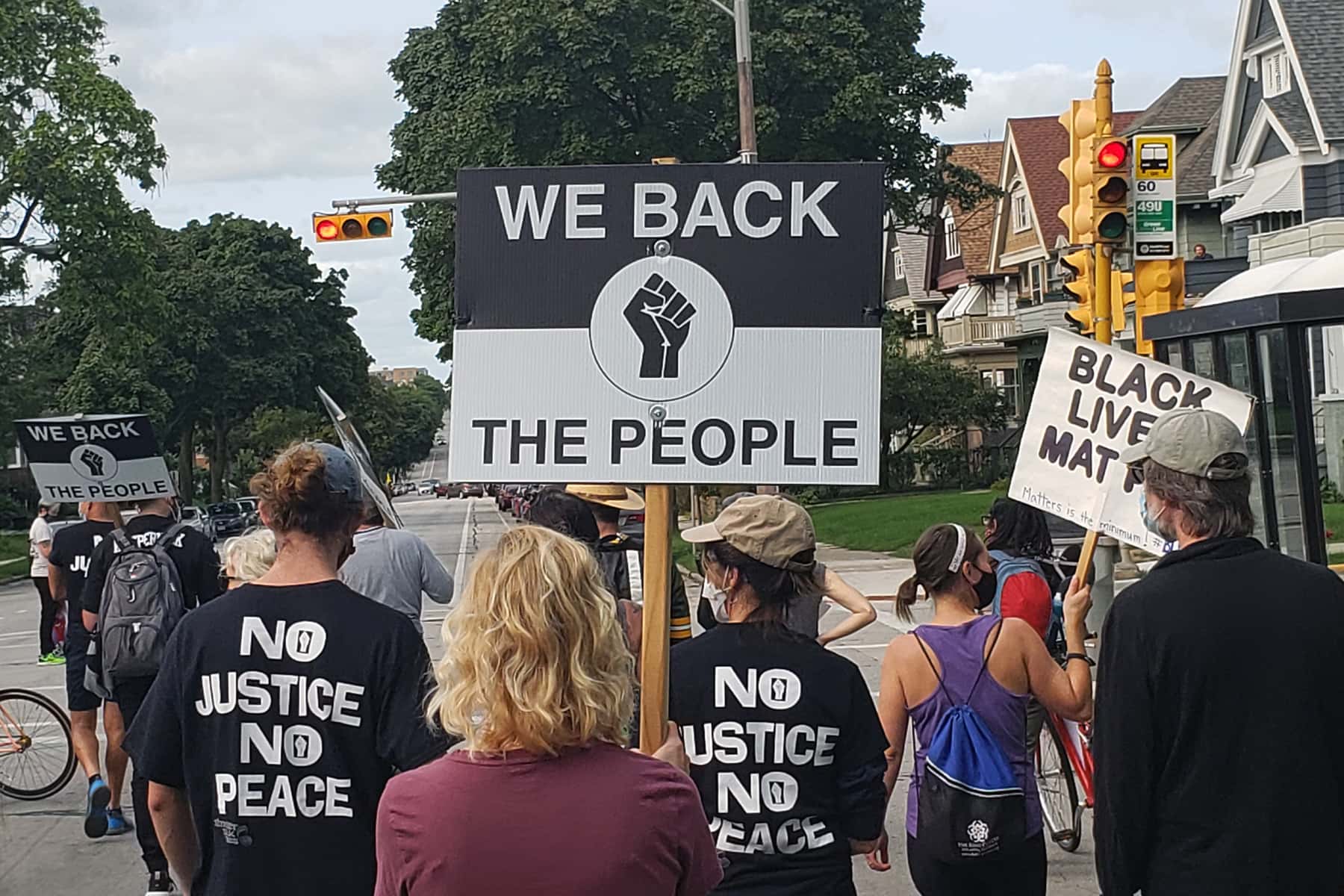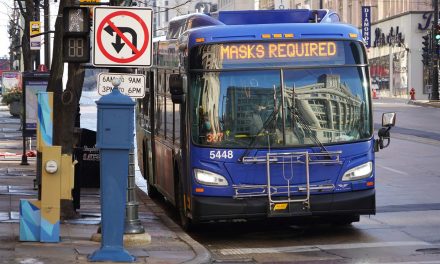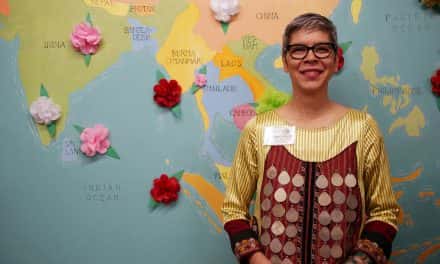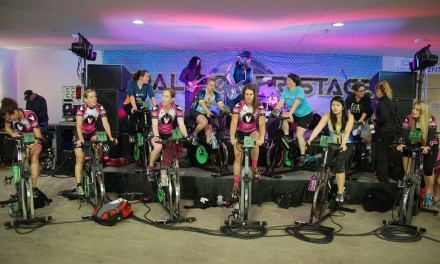
On Sunday, September 13, 2020, I marched for the thirteenth time this summer in a peaceful protest organized by Darius Smith and Charles McCoy. Dubbed “Come Together, Stand Together For Change,” this march of about 100 people looped from the North Point Water Tower up to Whitefish Bay and back again. After passing St. Mary’s Hospital on North Avenue to avoid blocking emergency entrances, the modest but loud group fanned out across both lanes of traffic and headed up Oakland Avenue. We moved to one side of the road to let buses and a fire truck pass but, otherwise, bike corks rode ahead to block intersections and redirect traffic. At Locust and Oakland, among other intersections, we stopped to chant, hydrate and pass out signs to motorists and onlookers. It was about here that my voice began to crack.
Blocking busy intersections and the flow of traffic are powerful forms of civil disobedience. We take for granted the yellow center lines, the broken white lines, the crosswalks that create a sense of trust between drivers, bicyclists and pedestrians. We trust that other travelers will stay in their lanes, follow traffic rules and mind the flashing signs.
But when lines of trust have been repeatedly broken and when systems and laws have consistently and insidiously and blatantly excluded Black lives, then it’s time to cross those lines, block the flow of racist ideas and actions, swim against the stream and march through some red lights – even if it means temporarily inconveniencing some of our fellow travelers, even if it’s technically illegal.
In a July 27 press release, 5th District Alderwoman Nikiya Dodd asked, “Exercising one’s First Amendment right is protected and critical, but do protests featuring illegal activities trump the quiet enjoyment of one’s home and neighborhood?”
Indeed, they do. Yes, they “block and clog up residential streets,” as Alderwoman Dodd said, and yes, there have been other “illegal activities” like “smoking marijuana and grilling food in the street,” but a protest march is an act of civil disobedience, a blocking, an inconveniencing, an interruption, a disruption. It disrupts people’s routines, their quiet, their expectations for a Sunday afternoon enjoying the first sunshine in over a week on their front porch. But it can also – as it did Sunday, September 13 – rally people’s voices, their cheers, their raised fists, and even their musical instruments.
While marching past UW-Milwaukee, a saxophonist on his porch began riffing over the rhythmic chants of “Black boys matter! Black girls matter! Black trans lives matter!” Elderly white women pumped their fists to the sky from fourth floor apartment balconies, white men walking their dogs accepted and held up posters proclaiming “We Are One,” and a white woman at a bus stop kept screaming “Black Lives Matter!”
A Black couple enjoying a patio meal were overjoyed to see us, and an elderly Black woman – well, all I could do is wonder what was going through her mind when she held up the “We Are One” sign: One more decade of protesting?
To her credit, two days after her initial press release, Alderwoman Dodd released another one expressing her new understanding of the protests and their tactics, after speaking with a number of the protesters themselves: “Protests are a first amendment right, and no one has any right to tell someone how to participate in civil disobedience.”
Aside from civil disobedience, the summer of protests have raised the issue of recklessness during the pandemic. Each time I’ve marched, I’ve had to convince myself that our right to public speech overweighs, in the moment, public health. Whereas I have avoided crowded restaurants and am cautious even at outdoor events, I know that the minute a march begins, I know I’m abandoning my private self and joining something much bigger than that. Yes, everyone is masked. But no, we’re not physically distant. And we’re certainly not socially distant – that’s the point.
We’re in it with a social purpose. We have each made a conscious decision to “come together, stand together” in an historical moment that demands it even as it seems dangerous to do so.
It gives me hope that, contrary to many worries, the National Bureau of Economic Research conducted a midsummer analysis of protests in 315 large U.S. cities and found no evidence that protests were causing spikes in coronavirus cases. In fact, the authors of the white paper concluded, “When considering the results’ implications for the entire population: public speech and public health did not trade off against each other.”
In fact, we’re dealing with not one but two pandemics, one which has existed for less than a year, the other which has existed for four hundred years. The protesters are choosing their battles.
Therefore, I walked on Sunday, September 13, with my mask pulled up, and for the first time since I began marching, my throat got so hoarse that my voice started to crack. Rarely in my life have I yelled so loudly and authentically. And so I thought while we marched up Oakland Avenue: if our voices aren’t cracking, then we’re not speaking loudly enough. We’re not saying enough. We’re not speaking up, speaking out, speaking to people who need to hear the messages of the protest marches: Enough is enough. There are, of course, many different ways to “speak loudly.”
The People’s Revolution has been marching for well over 100 days and counting, taking the brunt of police confrontations and civic violence. Their voices helped remove Milwaukee Police Chief Alfonso Morales and have been condemning the abuses of the Wauwatosa Police Department.
Others like my colleagues at Milwaukee Independent speak loudly with their voices as historians and philosophers. Black, Brown, and Indigenous artists, entrepreneurs, and gardeners are using their creations to sustain their communities. White people confronting their privilege are learning when to listen and when to speak.
I have been fortunate to find my voice in my work with Black and Brown teens, my writing here and my photographic projects, all of which have given me opportunities to use my voice in quiet ways. The protests have developed my volume. Now, I just need to increase the frequency and force.
However we choose to use our voices, we need to interrupt and disrupt and inspire others to join us. And we need to do it with vigor. Whether a mighty roar during a protest or a quiet decision on an absentee ballots, our voices – and the systems of injustice that continue to roar back – need to crack.
© Photo
Dominic Inouye














